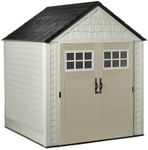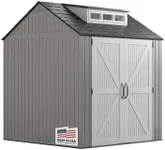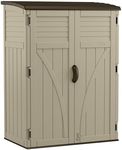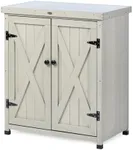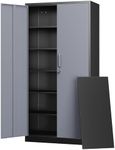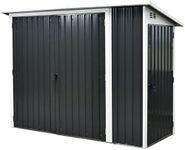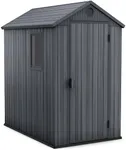Buying Guide for the Best Weatherproof Storage Cabinets
When choosing a weatherproof storage cabinet, it's important to consider several key specifications to ensure that the cabinet will meet your needs and withstand the elements. Weatherproof storage cabinets are designed to protect your belongings from rain, snow, wind, and other harsh weather conditions. By understanding the key features and specifications, you can make an informed decision and select the best cabinet for your specific requirements.MaterialThe material of the storage cabinet is crucial because it determines the durability and weather resistance of the cabinet. Common materials include plastic, metal, and wood. Plastic cabinets are lightweight, rust-resistant, and often more affordable, making them suitable for mild weather conditions. Metal cabinets, such as those made from galvanized steel or aluminum, offer superior strength and durability, making them ideal for harsher climates. Wooden cabinets, especially those made from treated or composite wood, provide a more aesthetic appeal but may require more maintenance to ensure longevity. Choose a material based on the typical weather conditions in your area and the level of maintenance you are willing to perform.
Water ResistanceWater resistance is a key feature for weatherproof storage cabinets as it ensures that your belongings stay dry even during heavy rain. Look for cabinets with sealed seams, waterproof coatings, and tight-fitting doors to prevent water ingress. Cabinets with a high water resistance rating are ideal for areas with frequent or heavy rainfall. If you live in a region with occasional rain, a cabinet with moderate water resistance may suffice. Consider the level of water exposure your cabinet will face and choose accordingly.
UV ProtectionUV protection is important for preventing sun damage to both the cabinet and its contents. Prolonged exposure to sunlight can cause materials to fade, crack, or become brittle. Cabinets with UV-resistant coatings or materials are designed to withstand sun exposure without degrading. If your cabinet will be placed in a sunny location, prioritize UV protection to ensure it remains in good condition over time. For shaded or indoor areas, UV protection may be less critical.
Size and CapacityThe size and capacity of the storage cabinet should match your storage needs. Consider what items you plan to store and measure the available space where the cabinet will be placed. Cabinets come in various sizes, from small units for garden tools to large ones for bulky equipment. Ensure the cabinet has enough internal space and shelves to accommodate your belongings. If you have limited space, opt for a compact cabinet with efficient storage solutions. For larger storage needs, choose a spacious cabinet with adjustable shelves for flexibility.
Security FeaturesSecurity features are important if you need to protect valuable or sensitive items. Look for cabinets with lockable doors, sturdy construction, and tamper-proof designs. Some cabinets come with built-in locks, while others may require a padlock. If security is a priority, choose a cabinet with robust locking mechanisms and consider additional security measures such as anchoring the cabinet to the ground. For less valuable items, basic security features may be sufficient.
VentilationVentilation is important to prevent moisture buildup and mold growth inside the cabinet. Cabinets with built-in vents or breathable materials allow air circulation, keeping the interior dry and fresh. If you plan to store items that are sensitive to humidity, such as electronics or paper, prioritize cabinets with good ventilation. In dry climates, ventilation may be less of a concern, but it's still beneficial for maintaining a healthy storage environment.
Ease of AssemblyEase of assembly is a practical consideration, especially if you plan to set up the cabinet yourself. Some cabinets come pre-assembled, while others require assembly. Look for cabinets with clear instructions and all necessary hardware included. If you are not comfortable with DIY projects, consider hiring a professional for assembly. Choose a cabinet that matches your skill level and the time you are willing to invest in setting it up.


